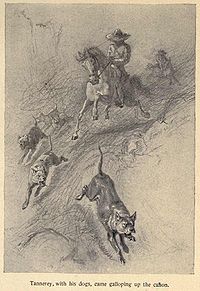
Wild Animals I Have Known
Encyclopedia

Ernest Thompson Seton
Ernest Thompson Seton was a Scots-Canadian who became a noted author, wildlife artist, founder of the Woodcraft Indians, and one of the founding pioneers of the Boy Scouts of America . Seton also influenced Lord Baden-Powell, the founder of Scouting...
. The first entry in a new genre of realistic wild-animal fiction, Seton's first collection of short stories quickly became one of the most popular books of its day. "Lobo the King of Currumpaw
Lobo the King of Currumpaw
"Lobo the King of Currumpaw" is the first story of author Ernest Thompson Seton's 1898 book Wild Animals I Have Known. Seton based the book on his experience hunting wolves in the Southwestern United States.-Summary:...
", the first story in the collection, was based upon Seton's experience hunting wolves in the Southeast United States. It became a classic, setting the tone for his future works that would similarly depict animals—especially predators who were often demonized in literature—as compassionate, individualistic beings.
Several years after its publication, Seton and his works came under fire during the nature fakers controversy
Nature fakers controversy
The nature fakers controversy was an early 20th-century American literary debate highlighting the conflict between science and sentiment in popular nature writing...
, which began in 1903 when naturalist John Burroughs
John Burroughs
John Burroughs was an American naturalist and essayist important in the evolution of the U.S. conservation movement. According to biographers at the American Memory project at the Library of Congress,...
published an essay called "Real and Sham Natural History" in Atlantic Monthly. In particular Burroughs blamed Seton's collection of stories for founding the sentimental animal story genre, which he felt featured fabricated events and wild animal behaviors; he even amended the title of the collection to Wild Animals I Alone Have Known.
External links
- Wild Animals I Have Known at Google Books

